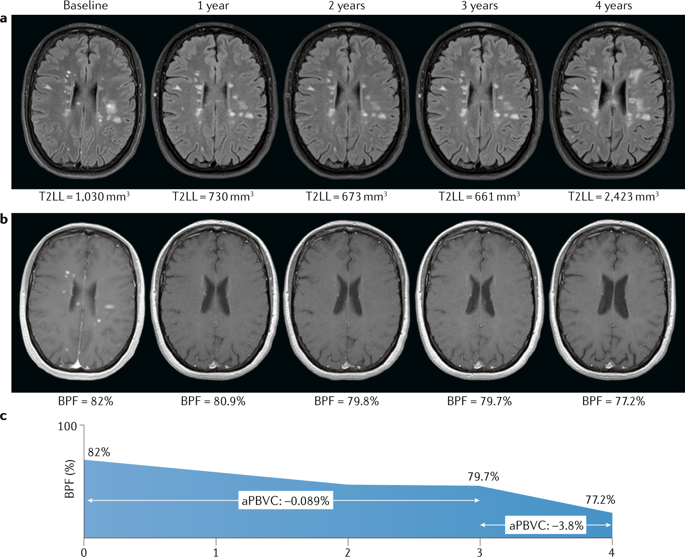当前位置:
X-MOL 学术
›
Nat. Rev. Neurol.
›
论文详情
Our official English website, www.x-mol.net, welcomes your
feedback! (Note: you will need to create a separate account there.)
MAGNIMS consensus recommendations on the use of brain and spinal cord atrophy measures in clinical practice.
Nature Reviews Neurology ( IF 28.2 ) Pub Date : 2020-02-24 , DOI: 10.1038/s41582-020-0314-x Jaume Sastre-Garriga 1 , Deborah Pareto 2 , Marco Battaglini 3 , Maria A Rocca 4 , Olga Ciccarelli 5, 6 , Christian Enzinger 7 , Jens Wuerfel 8 , Maria P Sormani 9, 10 , Frederik Barkhof 6, 11, 12 , Tarek A Yousry 5, 13 , Nicola De Stefano 3 , Mar Tintoré 1 , Massimo Filippi 4, 14 , Claudio Gasperini 15 , Ludwig Kappos 16 , Jordi Río 1 , Jette Frederiksen 17 , Jackie Palace 18 , Hugo Vrenken 11 , Xavier Montalban 1, 19 , Àlex Rovira 2 ,
Nature Reviews Neurology ( IF 28.2 ) Pub Date : 2020-02-24 , DOI: 10.1038/s41582-020-0314-x Jaume Sastre-Garriga 1 , Deborah Pareto 2 , Marco Battaglini 3 , Maria A Rocca 4 , Olga Ciccarelli 5, 6 , Christian Enzinger 7 , Jens Wuerfel 8 , Maria P Sormani 9, 10 , Frederik Barkhof 6, 11, 12 , Tarek A Yousry 5, 13 , Nicola De Stefano 3 , Mar Tintoré 1 , Massimo Filippi 4, 14 , Claudio Gasperini 15 , Ludwig Kappos 16 , Jordi Río 1 , Jette Frederiksen 17 , Jackie Palace 18 , Hugo Vrenken 11 , Xavier Montalban 1, 19 , Àlex Rovira 2 ,
Affiliation

|
Early evaluation of treatment response and prediction of disease evolution are key issues in the management of people with multiple sclerosis (MS). In the past 20 years, MRI has become the most useful paraclinical tool in both situations and is used clinically to assess the inflammatory component of the disease, particularly the presence and evolution of focal lesions - the pathological hallmark of MS. However, diffuse neurodegenerative processes that are at least partly independent of inflammatory mechanisms can develop early in people with MS and are closely related to disability. The effects of these neurodegenerative processes at a macroscopic level can be quantified by estimation of brain and spinal cord atrophy with MRI. MRI measurements of atrophy in MS have also been proposed as a complementary approach to lesion assessment to facilitate the prediction of clinical outcomes and to assess treatment responses. In this Consensus statement, the Magnetic Resonance Imaging in MS (MAGNIMS) study group critically review the application of brain and spinal cord atrophy in clinical practice in the management of MS, considering the role of atrophy measures in prognosis and treatment monitoring and the barriers to clinical use of these measures. On the basis of this review, the group makes consensus statements and recommendations for future research.
中文翻译:

MAGNIMS 关于在临床实践中使用脑和脊髓萎缩措施的共识建议。
治疗反应的早期评估和疾病演变的预测是多发性硬化症 (MS) 患者管理中的关键问题。在过去 20 年中,MRI 已成为这两种情况下最有用的临床旁工具,并在临床上用于评估疾病的炎症成分,特别是局灶性病变(MS 的病理标志)的存在和演变。然而,至少部分独立于炎症机制的弥漫性神经退行性过程可以在多发性硬化症患者的早期发生,并且与残疾密切相关。这些神经退行性过程在宏观水平上的影响可以通过 MRI 估计大脑和脊髓萎缩来量化。多发性硬化症萎缩的 MRI 测量也被提议作为病变评估的补充方法,以促进临床结果的预测和评估治疗反应。在本共识声明中,多发性硬化症磁共振成像 (MAGNIMS) 研究小组批判性地回顾了脑和脊髓萎缩在多发性硬化症治疗临床实践中的应用,考虑到萎缩测量在预后和治疗监测中的作用以及治疗中的障碍。临床上运用这些措施。在此审查的基础上,小组做出共识声明和对未来研究的建议。
更新日期:2020-02-24
中文翻译:

MAGNIMS 关于在临床实践中使用脑和脊髓萎缩措施的共识建议。
治疗反应的早期评估和疾病演变的预测是多发性硬化症 (MS) 患者管理中的关键问题。在过去 20 年中,MRI 已成为这两种情况下最有用的临床旁工具,并在临床上用于评估疾病的炎症成分,特别是局灶性病变(MS 的病理标志)的存在和演变。然而,至少部分独立于炎症机制的弥漫性神经退行性过程可以在多发性硬化症患者的早期发生,并且与残疾密切相关。这些神经退行性过程在宏观水平上的影响可以通过 MRI 估计大脑和脊髓萎缩来量化。多发性硬化症萎缩的 MRI 测量也被提议作为病变评估的补充方法,以促进临床结果的预测和评估治疗反应。在本共识声明中,多发性硬化症磁共振成像 (MAGNIMS) 研究小组批判性地回顾了脑和脊髓萎缩在多发性硬化症治疗临床实践中的应用,考虑到萎缩测量在预后和治疗监测中的作用以及治疗中的障碍。临床上运用这些措施。在此审查的基础上,小组做出共识声明和对未来研究的建议。











































 京公网安备 11010802027423号
京公网安备 11010802027423号